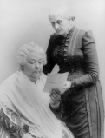 Susan B. Anthony (standing) and Elizabeth Cady Stanton were leaders in the struggle for women's rights. |
19th Century Women: Second-class Citizens
In the nineteenth century, when the women's rights movement was born, women were essentially treated as second-class citizens. They were just beginning to gain admission to colleges. That they were prohibited from the medical and legal professions, as well as the pulpit, stands to reason.
Women who were married had to surrender many of their rights, including the right to own property, to their husbands. Even some of the nation's founding principles, including the right to representation—in terms of taxation and any other governmental issues—did not apply to women, who could not participate in elections.
| The "Declaration of Sentiments," an equal-rights adaptation of the Declaration of Independence, received a great deal of ridicule, but also widespread publicity. |
The Seneca Falls Convention
The birthdate of the Women's Rights Movement is widely identified as July 19, 1848. While individual women had already begun to call for advancements in gender equality, it was at this time that Elizabeth Cady Stanton and Lucretia Mott organized the first women's rights meeting.
Held in Seneca Falls, N.Y., the historic convention was attended by about 300 women and men. Many of them signed the "Declaration of Sentiments." This equal-rights adaptation of the Declaration of Independence received a great deal of negative press, bringing the convention ridicule—but also widespread publicity that helped fuel the women's rights cause. In the decades that followed, women achieved many social and legal gains, including the ratification of the Nineteenth Amendment (granting women the right to vote) in 1920.
Modern Day Women
Today the number of women registered to vote exceeds the number of registered men by 8.3 million. In addition, women can not only expect to receive unbiased consideration by university admissions offices, but they are the majority gender of enrolled students. They can even earn their own income and not have to turn it over to their husbands. As strange as this sounds now, it was not always the case.
While stumbling blocks such as equal pay and achieving the presidency remain to be conquered, women are in a good position to do so. Women's History Month, which has been observed nationally since 1987 (and as Women's History Week from 1981-1986), celebrates the trailblazers who helped women to secure a more equal place in society.





